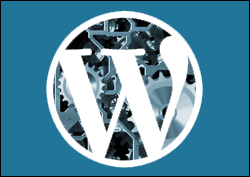
Welcome to Part Three of our Web Site Traffic Blueprint article series, where we show you how to automate traffic to your website using the WordPress CMS.
In Part 1 of this article series, we described the process, and explained why using an expertly configured WordPress website is the key to generating automated web traffic …
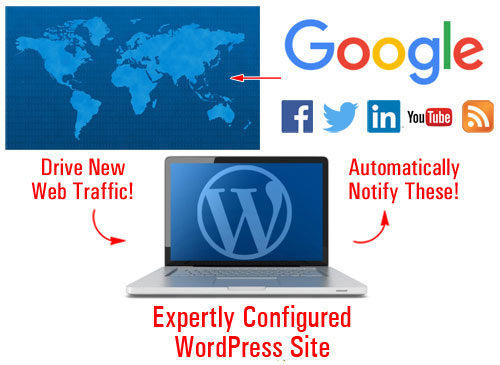
(With an expertly configured WordPress website, all you have to do to automatically begin attracting new traffic is post web content on a consistent basis!)
In Part 2, we discussed the setup phase of the automation process. We explained the best way to get started if you don’t have a web presence yet, how to set things up if you already have a site, and what to do if your website was built using WordPress.

(In Part 2 we show you where to set up a WordPress web site on your domain)
In this section of the series, we will discuss the configuration stage of the traffic automation process. We explain why an expertly configured site is different from a professionally configured website. You will also understand just what kind of work needs to be done to ensure that when all is set up and configured, you can start to get web traffic automatically when you begin posting new content on a consistent basis to your site.
WordPress Traffic Automation System – Configuration Phase
The ability to attract more visitors to one’s website is often cited by most website owners as one of their greatest challenges online. Businesses are becoming increasingly more competitive on a global scale and are looking for any opportunity they can to get better results online.
Having the ability to generate traffic on demand can be a tremendous advantage over other competitors. For businesses, having an expertly configured website means having an immediate competitive advantage from the very beginning.
Configuration Is The Difference
There is a significant difference between an expertly configured WordPress site and a website that has been professionally installed and set up by an expert website builder but not necessarily configured to take advantage of everything WordPress can offer.
Here’s a simple way to explain the differences:
With a WordPress site that has been expertly configured you get a professional web presence plus an automated online business marketing process!
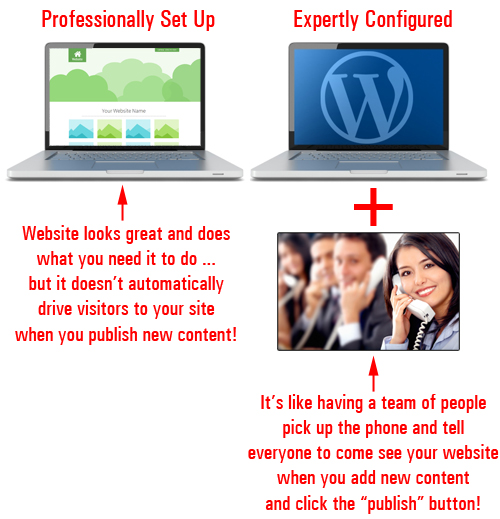
(An expertly configured site gives you a professional web presence and an automated online business marketing system!)
Not only does a whole lot more labor go into building and integrating an automated online business marketing process into your website, but also a special kind of expertise.
Allow me to illustrate this point with an amusing little story.
Ludicrous Or Fair? You Decide …
Things were going according to schedule in the widget assembly line when everything suddenly came to a halt.
No one could figure out what has happened and so the floor manager decided to call in an expert.
Promptly after arriving, the expert headed out directly to the main control box. After staring at the schematics for no more than 2 minutes or so, the expert then took out a teeny-weeny hammer from his tool belt and made a single tap near the left-hand edge of the box.
Immediately, everything came back to life.
The floor manager was filled with joy as he thanked the expert, who left as quickly as he had arrived.
A couple of days later, the factory manager received an invoice for $5,000.
The factory manager dialled the expert, demanding to know why they were charged so much for so little time spent delivering a minimal amount of work. He then requested an itemized invoice before hanging up.
The next day, an invoice notice arrived in the manager’s in-tray. Upon opening the envelope, this is what he saw:
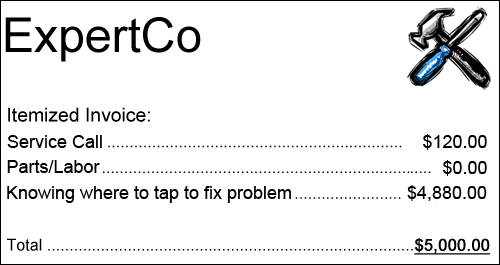
The #1 challenge most businesses face online is being able to consistently drive web traffic to their sites.
In the story we’ve just described, how much money did the widget plant stand to lose when production stopped functioning and no one in the factory floor was able to fix it? Did the expert in our story not have the right to demand fair compensation for years spent developing the knowledge, skills and expertise that allowed him to immediately assess and fix a costly problem?
Similarly, if you could have a blog set up and configured so all you have to do is publish content to it and Google, Facebook, Twitter, LinkedIn, YouTube and dozens of other traffic-generating online properties would be automatically notified, how much time and money would this save you?
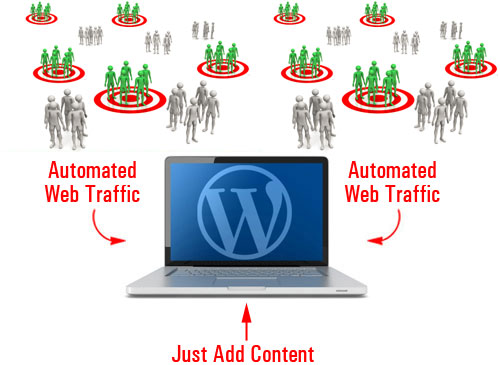
(How much time and money would you save if you could automate the process of driving traffic to your website?)
Although experts often make complicated things look simple, it rarely is that simple or easy when you try to figure things out.
Expertly configuring a WordPress site involves more than adding some pages with content and configuring basic settings. It also involves knowing where to tap! This includes knowing things like:
- Which programs you need to install to get desired functionalities on your site.
- Which accounts need to be set up to achieve specific results
- Which internal and external settings need to be configured in order to make sure everything will work as you have imagined, etc.

(Generating traffic automatically with WordPress is a process that requires expertise)
This part of the WordPress traffic automation system is not technically challenging, but it’s quite involved and complicated. The reason why is because it’s not as simple as installing and configuring a plugin, tweaking some settings in your dashboard area … it’s all of this and so much more.
Expertly configuring your website is a process that involves your server, your WordPress site, and various external sites and services …
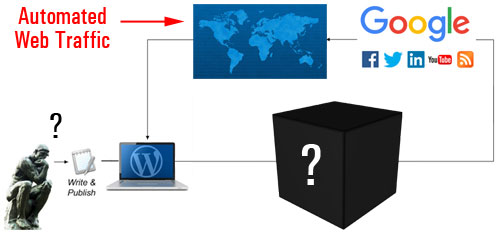
(Expertly configuring your website involves more than just configuring some WordPress settings)
If we create a simplified diagram showing all the steps involved in the configuration process, it would look something like this …
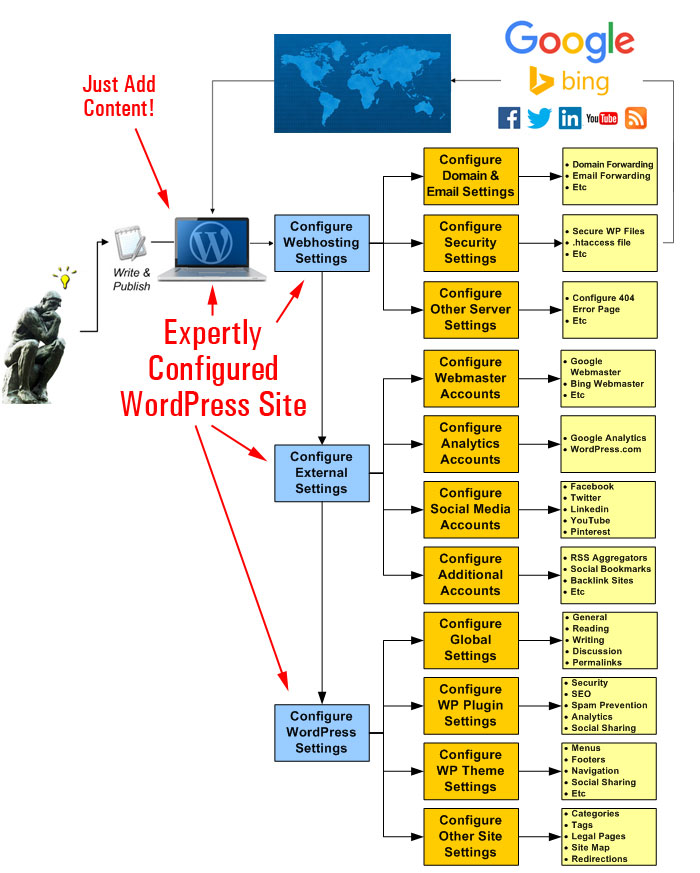
(A simplistic flowchart showing the activities involved in the configuration process)
Let’s examine what’s involved.
Your Web Server
We’re not talking about the process of configuring your hosting account for site installation purposes (this should have been done during the Setup phase). We’re talking about tweaking settings and options in your web server that affect how your site will handle all web traffic …
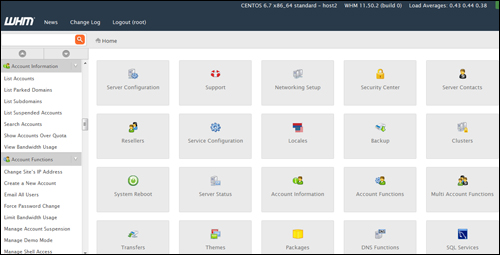
(In the configuration stage, your server settings need to be checked for handling both good and bad traffic)
Not all traffic is beneficial traffic. Some of the web traffic you may attract will be unwanted traffic like bot spam, malicious threats, bot-hacking attempts, etc.
This area of the configuration process, therefore, is about planning for good and bad traffic and then adjusting settings in your server accordingly. This includes things like spam protection and securing server files, to configuring domain and email forwarding, setting up htaccess and error page redirections, etc …
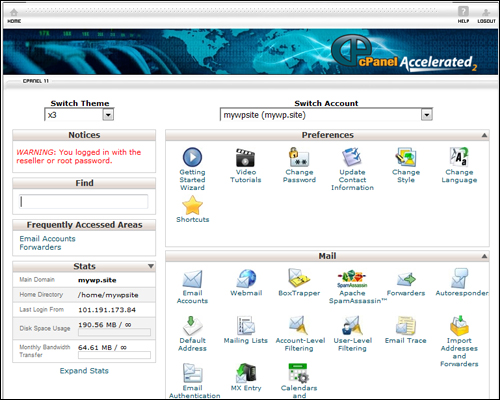
(Have you configured your control panel settings for handling things like emails, page error redirects, etc?)
Once your web server settings have been fine-tuned and configured (if required), the next step of the configuration phase is to set up various third-party sites.
Integration With External Web Properties
The idea behind adding external sites is that all of your content gets published from a central location (your WordPress site) and from there, it gets syndicated automatically to other parts of your traffic generation system, or notify traffic-related web properties and applications.
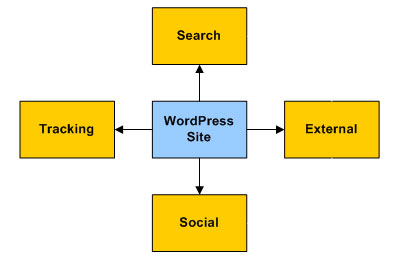
After incorporating these external services into your configuration, content with links pointing back to your website will be automatically syndicated to search, social and aggregator accounts. Your content and website will receive additional exposure online, helping you tap into a new audience and source of traffic.
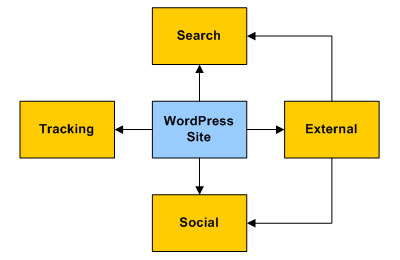
Some of the external sites will need to be set up before configuring your settings to save time and some will need to be done later, during the automation phase.
For example, here are just some of the accounts you will need to have set up:
Google Search Console
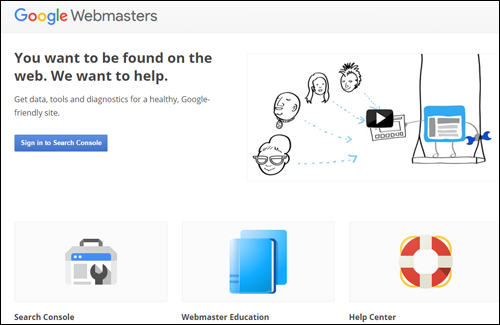
(Google Webmasters)
Google Webmaster Tools lets you tell Google about your site’s pages, submit XML sitemaps for faster page indexing, and provides you with a range of essential data, SEO tools and diagnostic reports about your website.
Once your Google Search Console account is set up, this information can be used to automate web traffic-related settings in WordPress and other applications.
Google Analytics

(Google Analytics)
Google Analytics lets you improve your website’s results, SEO, user engagement, marketing efforts, and more, by tracking all user behaviour, pages visited, keywords searched for, search engine referrals, etc.
After setting up your Once you have set up your Google Analytics account, you can add visitor tracking information to WordPress via any of several Google Analytics plugins and send data automatically to various other useful applications and web properties.
Bing Data And Tools
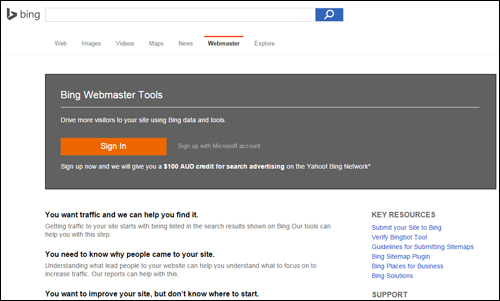
(Drive more traffic with Bing Data And Tools)
Bing Webmaster Tools is similar to Google Search Console. After setting up your Bing Webmaster Tools account and entering site details, your account details can be used to automate web traffic-related settings and notifications in WordPress using plugins like Yoast SEO and other applications.
WordPress.com
(WordPress.com)
As explained in Part Two, WordPress provides users with a hosted and a self-hosted option. We recommended choosing the self-hosted WordPress version if you plan to build a professional web presence.
WordPress.com (the hosted option), however, provides some great tools, which various WordPress plugins can access. We recommend setting up an account with WordPress.com, therefore, and we’ll explain how to integrate these features into your automated traffic generation system in Part 4 of this article series.
Social Media Accounts

(Syndicate your content automatically to your social media sites and get new visitors to your site)
You will need your social media accounts set up in order to integrate these with your traffic generation system.
After setting up and configuring everything, you will be able to syndicate your content automatically to your social media and social bookmarking accounts and drive new visitors to your site.
Make sure you have accounts and pages set up with all of the popular social networks – Facebook, Twitter, YouTube, Pinterest, LinkedIn, etc.

There are many social bookmarking sites you can You can post your content to loads of social sites. You don’t need to go crazy, just choose those that will work with your setup and/or content sharing tools (we will cover some of these tools in more detail when we discuss the Automation phase).
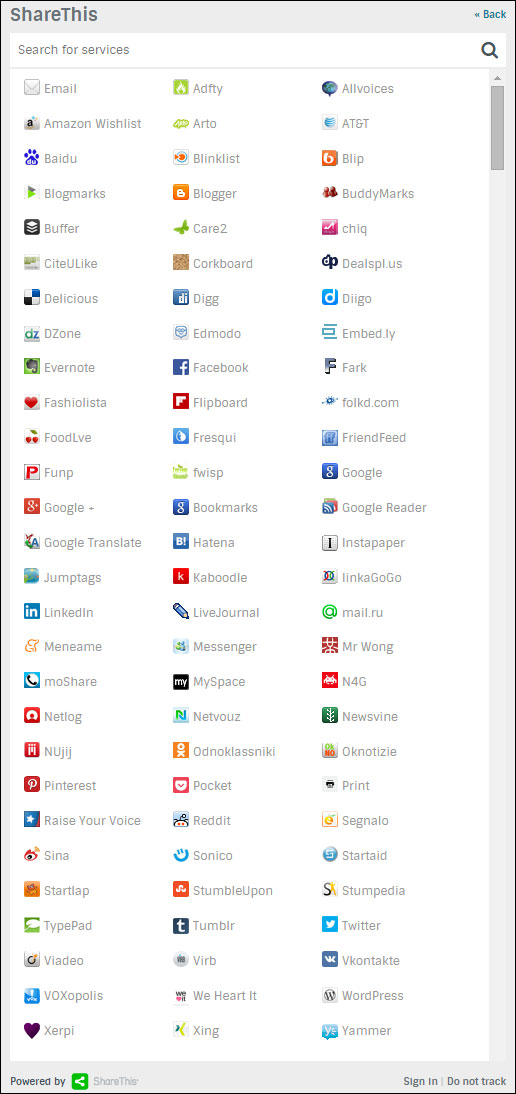
(You can syndicate your content to lots of social sites. Image source ShareThis.com)
Additional Solutions, RSS Aggregators, Etc.
There are a number of online platforms and content aggregators that can act as secondary traffic generation sources. Some are free or provide free accounts, and some are paid services.
For example, here is a content aggregator site that lets you add a feed from your website …
RebelMouse
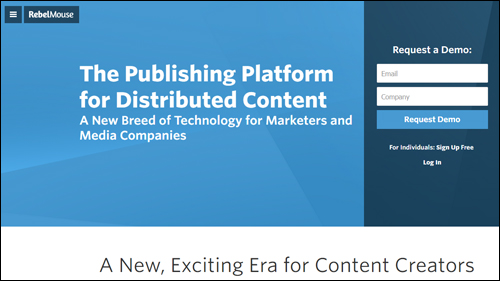
(RebelMouse)
RebelMouse is an aggregator for your RSS feeds and social profiles. Your content displays in a Pinterest-like format and visitors can follow your social feed.
![]()
There are many different solutions that can be added to your web traffic blueprint. Please contact us if you would like to explore some of these further and discuss a configuration strategy to suit your needs.
Once you have configured your server settings and set up accounts with third-party sites, it’s time to configure your WordPress settings.
WordPress Traffic Configuration
The first step in configuring your site for traffic is to make sure that your global settings have been correctly set up.
Let’s go over some key areas.
Global WordPress Settings
Your WordPress dashboard area contains a Settings menu that allows you to modify your site’s main settings …
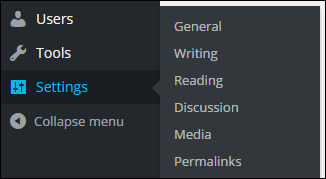
(WordPress menu – Settings)
General Settings
Sections like Site Title and Tagline can influence your site’s SEO, search listings, etc …
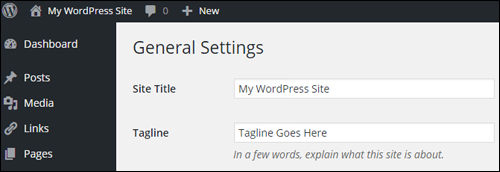
(Settings Menu – General Settings Screen)
Writing
The Writing Settings area contains a powerful and often overlooked built-in traffic notification system …

(Settings Menu – Writing Settings)
As stated below the Update Services section,
When you publish a new post, WordPress automatically notifies the following site update services …
Unless you have specifically chosen to prevent search engines from indexing your site, then your site will automatically notify the list of update services entered into the Update Services text area
With an ‘out of the box’ WordPress installation, only one service is listed …
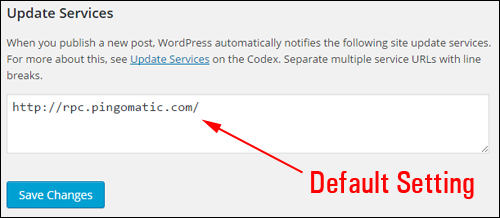
(Update Services – A Powerful Traffic Feature)
WordPress lets you notify dozens of update services automatically …

(WordPress lets you notify dozens of update services automatically!)
![]()
Download A Comprehensive List Of Ping Services For Your WordPress Site!
Click the link below to download a comprehensive list of reliable and authoritative ping services for your WordPress site or blog:
Download A List Of Ping Services For Your WordPress Site
***
Note: If you need help setting up the list of ping services on your site, we recommend using a professional web services provider. You can find professional WordPress service providers in our WordPress Services Directory.
Reading Settings
This section affects how your content gets seen by visitors when they visit your home page and blog pages.
The syndication settings in this section can have an influence web traffic. For example, choosing to display the full text vs summaries of your post, affects how your content displays to users in RSS readers and RSS email campaigns, and could impact someone’s decision to explore your site further, and whether or not they will visit your site to read the rest of the content from excerpts, or read the content in full without the need to click through to your site.
The main setting in this section as far as traffic is concerned is whether the Search Engine Visibility checkbox is ticked or not.
Typically, you want search engines to visit your site. Leaving this box unchecked enables WordPress to notify various update services when a new post is published (see Writing Settings above). Unless you have a specific reason why search engines should not visit your site, do not check this box …

(WordPress Settings – Reading Settings)
Discussion Settings
Although discussion settings are mostly concerned with how users engage with content on your site, you have the option to allow notifications to sites linked to from your content, and to allow link notifications from other blogs (pingbacks and trackbacks). This can work for you, but it can also drive bad traffic in the form of SPAM comments …

(Global Settings – Discussion Settings)
Permalinks
Permalinks allow you to create SEO-friendly URLs …

(WordPress Settings – Permalinks)
The examples below show some of the options for configuring your site’s permalinks …

(Configuring SEO-friendly URLs)
If you need help setting up permalinks in WordPress, go here: Using Permalinks To Improve Your WordPress SEO
Plugin Settings
WordPress provides users with thousands of plugins that help to add just about every type of functionality imaginable to your website, including traffic generation.
Let’s take a brief look at examples of plugin categories and plugins that can help to bring more visitors to your site
Blog Defender
Once again, it’s important to configure your site for handling both good traffic and bad traffic. No site is safe from a cyber attack.
 (WordPress Security Plugins help prevent bad traffic from causing your website harm)
(WordPress Security Plugins help prevent bad traffic from causing your website harm)
Security plugins like Blog Defender help to make your website invisible to bot and hacker attacks.
Go here for more information:
SEO Plugins – Yoast SEO
SEO plugins help drive traffic by making your site more search engine friendly …

(SEO plugins help increase traffic by improving your website’s SEO)
A plugin like Yoast SEO (previously called WordPress SEO by Yoast) can significantly improve your SEO. Once properly configured, the Yoast SEO plugin not only makes your site easier for search engines like Google to find and index, it also gives you control over how your content is displayed to Google’s search results and social media pages, e.g. Facebook, Twitter, and Google+.
Social Sharing Plugins
Allowing visitors to easily share your content online can help boost traffic to your site, especially if you publish great content that adds real value to readers.

(WordPress users can easily add social sharing features to their site with WordPress plugins)
WordPress users can easily add social sharing buttons to their site with free or inexpensive WordPress plugins.
Most social sharing plugins let you select which social sites visitors can share your content to, embed social buttons into your content, set up default update notifications, display/hide share counters (e.g. number of shares), etc. Some social sharing plugins even allow you to ‘lock’ content which visitors can unlock by sharing your page.
Themes
As well as configuring various plugins, many WordPress themes also include features that help you drive more traffic to your site.
For example, as well as options and settings for configuring the layout and design of your website, some themes also include options for improving SEO and site linking structure for better indexing, add analytics snippets, social sharing buttons, etc …

(Many WordPress themes can be configured for improved traffic results)
With a number of themes, adding social sharing buttons to your site is as easy as selecting the option to enable this functions …

(Many WordPress themes provide built-in social sharing features)
WordPress Traffic – Other Important Sections To Configure
Last but not least in the traffic configuration process, are the elements that need to be configured outside of the global settings.
These include:
Website Legal Pages
Once again, when preparing your site for a growth in traffic, it’s important to plan not only for how to deal with good and unwanted traffic but also for all the situations that can cause serious damage to your business as more and more people begin to visit your website.
If you do any kind of business online, you need to make sure that your website stays compliant with regulatory agencies.
 (Is Your Website Or Blog Compliant?)
(Is Your Website Or Blog Compliant?)
We have created a detailed article on the importance of having a legally compliant website here:
Post Tags And Post Categories
WordPress tags and categories help improve traffic by allowing search engines to better index your web pages.

(Post categories help to improve your site’s search engine optimization, which helps to increase traffic.)
As we strongly recommend in this article, it’s best to review and set up your site’s tags and categories during the Website Planning Process.
When configuring your website to automate and improve web traffic, you will want to review and make sure that the categories and tags that have been set up.
Add A Site Map
A site map that lists all of your site’s pages and posts to visitors is not only a useful navigation tool for users, it can also help external sites discover your online content …

(A site map is not just great for visitors, but for traffic too!)
![]()
Note: An HTML site map and an XML sitemap are not the same things. Although search engines like Google can index your site just from an XML sitemap (which plugins like Yoast SEO can provide – see earlier section), allowing visitors to find more pages on your site can result in increased traffic.
Configure Your 404 Error Page
When visitors searching for your site type in the wrong URL or click on a dead link, they are presented with a 404 error page …

(Default WordPress 404 Page)
A 404 page can be configured to funnel visitors to your functional pages …

(Configuring your 404 Not Found error page allows you to recover web traffic that may otherwise be lost.)
![]()
Although a 404 page can be set up in your web server, there are plugins for WordPress that allow you to easily configure your 404 page inside your WordPress dashboard.
WordPress Traffic System: Configuration Phase – Summary
Once you have your website expertly configured and fully set up, all you then need to do is publish great content on a regular basis to attract web traffic organically.
The process of expertly configuring your WordPress site, however, is quite involved and elaborate , requiring the configuration and integration of different elements and external web properties …

(WP Traffic System – Configuration Checklist)
![]()
The skills and knowledge involved in expertly configuring a WordPress site can take some web professionals months to acquire.
Once you have expertly configured your WordPress site, the next step is to automate the process. This step is covered in the next article in the series.
This is the end of Section Three
To read the rest of this article, click on the link below:

![]()
This article is part of a comprehensive series of articles designed to help business owners learn how to grow their business online and drive traffic organically with a WordPress-powered website or blog and proven online marketing strategies.
Subscribe To WPCompendium.org And Get Notified When New Tutorials Get Published!
***
"I was absolutely amazed at the scope and breadth of these tutorials! The most in-depth training I have ever received on any subject!" - Myke O'Neill, DailyGreenPost.com
***
